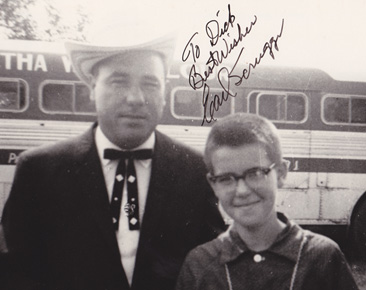By the time I started school in 1958 I was hearing the sounds of Flatt & Scruggs, Mac Wiseman, Bill Clifton, The Stanley Brothers, the Osborne Brothers, Reno & Smiley, and Jimmy Martin along with reissue LPs of the old Carter Family records.
In those days you bought LPs at music stores, furniture stores, drug stores, etc. I remember Dad and Mom scouring the LPs for anything “with 5 string banjo!” as they used to emblazon the covers back then, as the folk music boom exploded.
I got a guitar from an uncle when I turned 8 and I was off! We all played with thumbpicks then, so I learned the guitar copying Mother Maybelle leads, and runs and licks like Lester, Carter and the rest. I was TOTALLY enthralled with Earl’s guitar pickin’, so I got some finger picks and learned his 3 finger style. I could play all of Earl’s 3 finger breaks by the time I was 10! I learned to use a capo playing along with Earl’s guitar breaks on those LPs. I “almost” got Dad to buy a 12 string guitar in the mid-60s ‘cuz Earl was picking some breaks on a 12 string – The Soldier’s Return and some others.
Dad bought a new Gibson RB 100 banjo in 1964, that he thought he was going to learn to play. At age 10, I was forbidden to touch it! But I was happy picking the little Gibson guitar I bought with my own money.
Until…
Aug. 30 1964, the family went to see Lester & Earl all the way off in far flung West Grove PA at Sunset Park. We heard it advertised on WWVA radio which came in great up in Maine. At the time I was most hopeful of meeting Buck Graves, as I had become real interested in the Dobro. However, Uncle Josh was far too busy as the band “go-fer,” and I never so much got to speak to him or shake hands.
However…
All of this experience culminated in me ignoring the rules and pulling that RB-100 out of the case when I got home to Maine again. I played all the LPs again, this time listening to just THAT BANJO. I was MARKED. We soon traded up to a Mastertone, and they rest, as they say, is a wasted life.
Decades later at IBMA in Kentucky, I got a friend to take that photo of 10-year-old me with Earl to the Gibson table where he was signing autographs. Earl very nicely autographed the photo and a Gibson poster. I was nearly 50 years old then, but still too shy and in awe to speak to Earl in person!
Through a producer buddy of mine I got invited to sing at a recording session in Nashville right around 2001 or so. Imagine my shock when into the studio sauntered Earl and Ms. Louise! Earl was gonna pick on the song too! My larynx started to tighten up pretty quick! I got to watch and listen to Earl work, while trying to do my part singing. Too bad that recording never was released.
A couple of years ago on a business trip to South Carolina, a buddy and I took the ride to Boiling Springs, NC. We met a relative of the Scruggs family who told us how to find the place Earl was born down near the Broad River. While the place looked pretty rough, we still felt we had made quite a pilgrimage. We soon learned that a Scruggs museum was being planned for Shelby. It seemed ridiculous to me that Earl should have a musuem in his home town that would compete with a museum for his neighbor Don Gibson too, but I suppose some Don Gibson fans may feel the same way.
I can tell you I swelled up with pride when Earl appeared on the David Letterman show a few years agos with “Men With Banjos Who Know How to Use Them” — Paul Shafer’s piano break on FMB included.
I’ve felt pretty bad about Earl for the past year or so, it seemed obvious he was “failing” as the old folks say. But if he was still game to get out and perform, then more power to him. When I heard the bad news last week I thought, “God speed, now you can rest ol’ feller.”
Ever since I was 11 years old Earl has been bigger than life to me. He looms over my own life. I’ve picked the banjo for nearly 48 years now because of Earl Scruggs (for better or worse!). But when I think back to the beginning, I still remember his guitar breaks. On the last recording I made in 2010 I didn’t pick any banjo, but I played a Scruggs-style 3 finger GUITAR break on a gospel song! And the last REALLY good, deep catalog discussion I had concerning Earl’s musical legacy was about his his guitar playing, with Jimmy Mills.
Don’t get me started about Earl’s nearly unnoticed baritone harmony singing skills…
